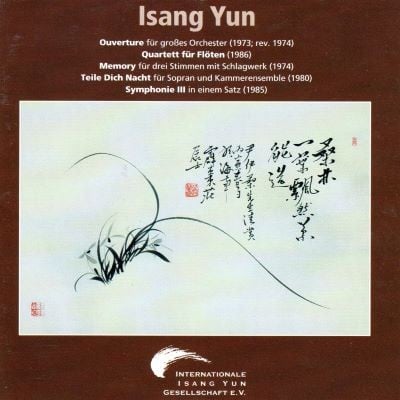2(I,II=picc).2.2(II=bcl).2(II=dbn)-4.3.2.1-timp.perc(2):guiro/vib/tamb/2maracas/5tom-t/cel/xyl/5gong/jingles/glsp/SD/BD/2tgl/5tpl.bl/2tam-t/5cym-strings
Abbreviations (PDF)
Bote & Bock
Yun described his Symphony III (1985) as "philosophical." The three parts of this one-movement work follow the sequence fast-slow-fast. While Yun structured the unfolding of opposites relating heaven, earth, and humanity in the name of the Tao as a simultaneous sound layering in his orchestral piece Dimensions (1971), in the symphony this unfolding occurs in the succession of competing sound worlds. Ideal-typically, Yun assigns certain meter and tempo types to certain instrument groups on each occasion. Three sound worlds are juxtaposed; three characters determine the structure. The strings, for Yun the symbol of heavenly purity, are assigned to 6/4 time with a quiet meter, but the brass instruments and timpani, symbolizing the dark and demonic, are notated in 4/4 time with a fast meter. The mediating, human world of the woodwinds is represented by 5/4 time in a middle tempo. This work commissioned by the Berlin Festival was premiered at the Berlin Festival Weeks by the Saarbrücken Radio Symphony Orchestra under Myung-Whun Chun in Berlin on September 26, 1985.
The slow middle section in 6/4 time with its bassoon, oboe, horn, flute, clarinet, violin, and trumpet is relatively uniform. In contrast, in the framing section there are frequent shifts of meter and tempo. If we follow Yun’s metrical divisions, then the first part has eleven phases of different length and the third part seven such phases alternating in rondeau-like mirroring.
Ideal, breaking-in, and destruction occur in succession in the first twenty measures. The buildup of the double basses with a melody consisting of seconds, third, and fourths is answered by the violins in continuous ascent. This two-part oval capsule in measures 1-13 anticipates on the small scale of the microcosm the pitch course of the whole as a macrocosm. This capsule is filled in concretely by the following four-measure phase of the brass instruments with timpani, gourd, and bells. Afterwards trill chains in thirds and seconds in the woodwinds sound disturbed; their "indeterminacy" is stabilized by the horn and tuba.
What follows is the rotating "repetition" of this process expounding three sound worlds. A process of mutual influence occurs with different instrumentation, in no way schematically, and with different durations. The "purity" of the fourth phase (6/4 time) is clouded by an increasing degree of dissonance, but the following "destructive" wind block (4/4) brightens it up. The sixth phase (6/4 time) brings not only double basses and violins but also woodwinds, vibraphone, glockenspiel, and harp. Here at the very latest the principle becomes clear: in order to stand up to the physical strength of the brass instruments, the "pure" sound world has to incorporate increasingly "impure" elements.
The third part of this composition with a dramatic line of constant intensification witnesses extremely violent outbursts in the brass instruments. In keeping with the basic idea that hardness is to be tamed by softness, Yun’s Symphony III ends with a 6/4 phase darkened in color by the bass clarinet and contrabassoon. The tritone A - D-sharp fades away in the double basses and violins. In the composer’s symbolism the tone A stands for clarity and perfection. Its complementation would be the perfect fifth E. The tension of the half step from D-sharp to the (imaginary) E alludes to the work that still has to be done. What was attained as "work in musical space," however, can be rather precisely determined. The development leads from the diminished fourth g-sharp1 - c4 (bar 13) to the augmented fourth A - d-sharp4 (concluding measure 291) upwards in an expanded space but does so at the price of painful tension.
Yun himself stated of the Symphony III in Salzburg in 1993 that with it he had "exposed human blindness and egocentrism" and "wanted to give people something for reflection."
Walter-Wolfgang Sparrer (1996)

Rundfunk-Sinfonieorchester Saarbrücken / Myung-Whun Chung
Internationale Isang Yun Gesellschaft IYG 002
